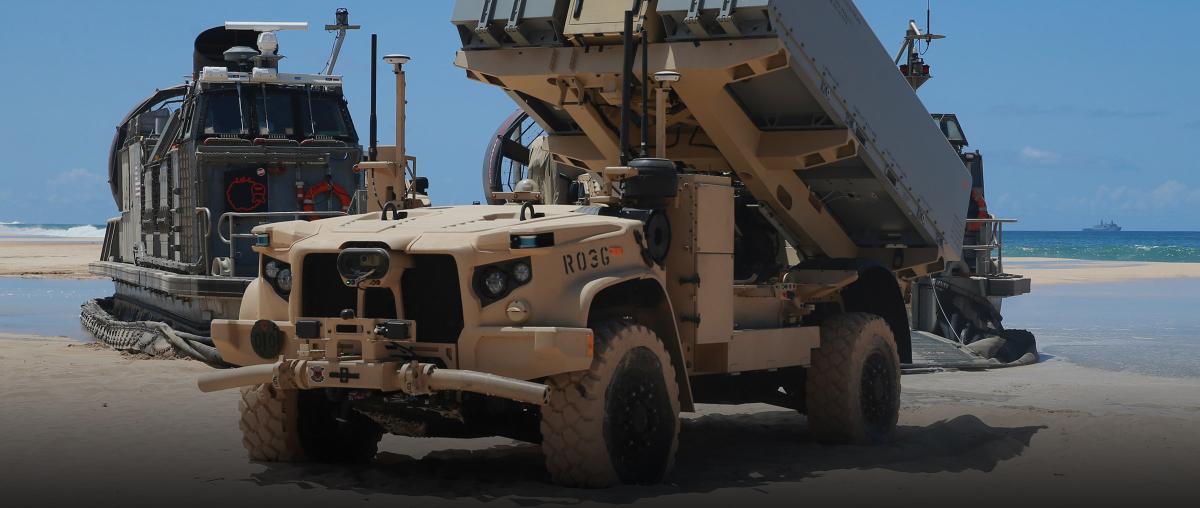The Marine Corps is about to field perhaps the most capable weapon system—apart from the rifleman—it has ever seen. The Navy and Marine Corps Expeditionary Ship Interdiction System (NMESIS)—which combines the Naval Strike Missile (NSM) with the Remote Operated Ground Unmanned Expeditionary (ROGUE) Fires system—will enable the Marine Corps to make a profound contribution to deterrence in littorals all around the world.1 The revolutionary nature of the system demands careful consideration of the command-and-control (C2) and operational concepts under which it is used, lest the service not exploit its full potential.
Four principles should underlie how the Marine Corps integrates this impressive system: resist the urge to simply update legacy systems to fit new capabilities and concepts; build system connectivity to the joint community; place greater emphasis on procedural control; and inculcate a willingness to trust the system and its capabilities.
Understanding NMESIS
A broad understanding of NMESIS as a system is a prerequisite for developing its full potential for supporting Marine Corps missions.2 The NSM is a subsonic, sea-skimming missile that uses a passive seeker, yet its autonomous target recognition (ATR) capability enables it to strike precise aimpoints on targets at ranges greater than 100 nautical miles (nm). In addition, the missile does not require GPS in flight to find and strike its target. Advanced terminal maneuvers enhance its accuracy, lethality, and survivability, making it ideal in a fight with a peer threat.3
The NSM is managed by a mission computer connected to a graphical user interface (GUI). This highly capable subsystem enables the user to, among many other things, build and load complex flight paths for multiple missiles, input and follow surface track data, and construct deconfliction zones based on geography or altitude. Its rapid automated mission planning capability enables short reaction times in a dynamic environment.4 In addition, the GUI is user friendly and highly efficient at displaying information and creating mission plans. It requires a single afternoon for a student to learn how to build a basic mission profile for one target, and less than two weeks to become proficient in building mission profiles for complex scenarios involving multiple friendly, neutral, and enemy surface tracks.
From a fire-support coordination standpoint, one of the defining features of the NMESIS mission computer is the ability to create and implement deconfliction zones. Once built, these zones act as fire-support coordination measures and are the dominant factor the computer will consider when building automated mission plans. All other user-defined inputs will bend to what the zone tells the system the missile is allowed to do.
NMESIS represents a step-function increase in the Marine Corps’ ability to overmatch adversaries in the littoral environment. But incorporating this new system into its operating concept will require a thoughtful approach that avoids several pitfalls that could hinder its full capability.
Don’t Put A Square Peg In A Round Hole
The NSM is a munition unlike any the Marine Corps has ever employed, and its control systems must serve that capability, not the other way around. It will be tempting for the Marine Corps to integrate NMESIS by simply updating legacy systems, such as the Advanced Field Artillery Tactical Data System (AFATDS).
This would be a mistake. Systems such as the AFATDS were not designed to track multiple moving targets or compile the data necessary for the complexity of NSM flight plans. While AFATDS is good at conducting C2 and fire direction within Marine Corps artillery units, it is not ready to operationally employ the NSM within the larger joint community.
Rather, upgrading the current NMESIS mission computer likely would take less time, cost less money, and require fewer pieces of equipment than integrating AFATDS into the loop—and ultimately result in a more effective system.
Integrate with Joint C2
When designing the system’s final architecture, the service should pursue capabilities as early as feasible that integrate NMESIS C2 within the larger joint “kill web.” Too often, advanced weapons are addressed in stovepipes as ends unto themselves rather than being treated as part of a larger system. The system’s mission computer should employ the same message types used by Link-16—the tactical data network link—which would enable section- and battery-level operators to pull and update track data automatically. Moreover, NMESIS needs to be “joint all domain command and control (JADC2) ready” from day one. That means its architecture must not only work with existing joint command-and-control systems (such as Link-16), but also must fit seamlessly into whatever form JADC2 eventually takes. Recognizing this imperative early will allow the Marine Corps to bring an incredibly capable shooter to the joint fight.
Traditionally, one sensor provides targeting data for one shooter in a closed kill chain. In a future fight, however, a sensor could provide targeting information to multiple air, surface, or subsurface shooters within a larger kill web. Firmly establishing NMESIS’s role within the joint kill web will validate the Marine Corps’ contributions to maritime control by providing joint commanders an additional strike option. It also will help solve a larger problem that JADC2 is supposed to address regarding weapons employment efficiency: getting the most appropriate weapon on each target rather than wasting multiple uncoordinated strikes against the same target.5 If NMESIS is not tied into JADC2, it might cause joint commanders to pause when considering its employment.
The future kill web will not only be concerned with the weapon-to-target matchup. NMESIS will have to integrate into joint situational awareness because of the novel deconfliction problem (and opportunity) created by the NSM’s long range, low-level, non-ballistic flight trajectory. While the Marine Corps is very good at deconflicting surface and air fires with maneuver forces in its own battlespace, NMESIS’s deconfliction and intended employment will require more in-depth integration with the joint force. Instead of managing a few maneuver units, aircraft, and firing agencies within well-defined boundaries, NMESIS operators will have to deconflict a missile’s flight path with hundreds of friendly, neutral, and enemy contacts. Even if the Marine Corps “owns” the entire “seaspace” within which a NSM will fly—an unlikely scenario—it does not possess the necessary sensor capability to organically deconflict the NSM along its 100-nm flight path.
Finally, joint integration must be secure and reliable. Future all-domain warfare will see an increased emphasis on electromagnetic attacks focused on breaking into a competitor’s digital communication loops. It is not enough for the system to be able to talk to joint players; operators must feel secure that the information they see is accurate.
Ultimately, NMESIS batteries are designed to supplement the joint force’s ability to strike moving targets at sea. Enemy movement means target data degrades with time, requiring direct communication between a joint sensor and the NMESIS battery to strike moving ships. This means that either fire commands will be sent from a joint targeting authority directly to the battery or, perhaps more likely, target engagement authority (TEA) will reside with the battery commander.
Positive Control Backed by Procedural Control
The more tightly integrated NMESIS is with joint C2 systems, the better. However, NMESIS batteries should be able to operate independently using procedural control when required. Three scenarios demonstrate the need for both positive and procedural control. In this case, positive control refers to a high-level joint agency’s control of which target to engage, which launcher to shoot, and the flight path of the missile. Procedural control relinquishes the control of one or more of those aspects to a subordinate command through tactical control measures (boundaries, fire-support coordination measures, etc.) and rules of engagement.
In the first, a NMESIS battery is closely tied to a higher-level joint C2 system and the TEA resides at a level above the battery or littoral regiment. A joint TEA would use positive control of target engagement and deliver fire commands directly to the battery. While this may be an ideal scenario, its efficacy may decrease for a variety of reasons once the initial salvos have been exchanged.
The opposite scenario occurs when the NMESIS battery is cut off from joint communication entirely. The battery might receive targeting data organically from attached sensors, or even find itself in a self-defense situation. This should not prevent the battery from executing a target engagement, but such a scenario will require procedural control—using preestablished coordination measures—and could enable a NMESIS battery to engage targets in its area of control without requiring outside approval. Autonomous engagements will be extremely important in a dynamic and kinetic environment in which U.S. communication networks will be targeted by the enemy.
The final scenario is a hybrid of the first two, in which a NMESIS battery is connected to the joint C2 system, but the TEA resides at the battery level. In this case, some externally provided situational awareness is available to the battery, but direction to fire has been either interrupted or delegated downward. Ships are difficult to target and engage because they adjust course and speed. Targeting data will only last so long before the joint community must risk another sensor for a more up-to-date picture. Empowering procedural control to a low-level, decentralized TEA (potentially as low as a battery commander) based on overall commander’s guidance and a common operational picture (COP) can allow for faster engagement.
A subordinate operations center that receives inputs from across the joint force could update deconfliction zones and track data in real time. Assuming the necessary C2 upgrades are complete, this information could be continually sent down from a joint authority to subordinate NMESIS units. If all players have the same real-time COP, NMESIS batteries can identify and strike surface tracks without lengthy deconfliction. This method of control will give commanders the confidence that all deconfliction will be conducted appropriately while giving subordinates, and the system, freedom to engage targets.
In all three scenarios, control of the missile flight profile should be left to the NMESIS batteries, which has many benefits and can best be accomplished through procedural control using a COP. Joint authorities would provide only no-fly areas as alluded to above—accelerating an otherwise lengthy approval process that would require significant data transfer between a battery and the TEA.
Maintaining control of the missile flight profile at the battery level has the benefit of reducing its electromagnetic signature. A NMESIS battery could passively receive updates to the COP with the only active transmission occurring when firing a missile. These passive updates would prevent the battery from having to unmask in the electromagnetic spectrum to send mission-profile data to a higher-level TEA for approval.
Perhaps most notably, procedural control of the flight profile would allow operators to use the automatic missile flight path generation rather than manually hitting predefined waypoints imposed by higher authority. Using automatic flight path generation allows for faster mission processing and allows the system to use the full capability of the missile when developing flight paths.6
Procedural control requires significant trust between commanders and subordinate units. Procedural control of a NMESIS battery through a COP will require commanders to trust not only their human subordinates, but also the systems’ coordination.
Trust the System—and Marines
While speaking at the National Defense Industrial Association’s annual expeditionary warfare conference, Marine Corps Commandant General David H. Berger said, “In the same way that a squad leader has to trust his or her Marines, the squad leader’s going to have to learn to trust the machine. . . . In some instances today, I would offer we don’t trust the machine.”7
To take full advantage of NMESIS, operators throughout the operational chain must trust the system. To achieve this, the service must destigmatize automating certain aspects of the kill chain—a stigma born of the fear that if the system malfunctions the operator will be held responsible. As a result, operators insert themselves into the kill chain to ensure automated systems are working correctly.
The difference between a typical artillery battery and NMESIS is that the service has been able to use artillery effectively without digital systems in the past. NMESIS, however, is foundationally a digital system. In a dynamic environment with moving targets, insufficient trust in the NMESIS systems will not only be a detriment, but also will prohibit its employment.
A well-known example of this exists today in the Marine Corps artillery community. Marine Corps observers possess the capability to digitally send calls for fire straight to howitzers on the gunline, which bypasses human interaction in technical fire direction and allows the computer inside the howitzer to calculate its own firing data to hit the target. Excluding humans from technical fire direction enables a faster kill chain. However, operators often lack trust that the observer’s data will be transmitted correctly and securely from sensor to shooter and that the computer in the howitzer will properly calculate firing data. The repercussions that accompany expending an unsafe round can compound this lack of trust—the digital system might have been at fault, but a human likely will pay the price. Lack of trust and fear of consequences build a stigma around digital fire-control systems in the Marine Corps fire-support community that will be detrimental to future NSM employment.
To operate effectively, digital systems rely on human trust in two areas. First, operators must trust that the C2 network is functioning properly. Data must be sent and received correctly, which will require well-trained operators on either end of the connection and rigorous testing to ensure data integrity. In addition, users must trust that the C2 network has been protected against cyberattacks to prevent the adversary from tampering with target data.
Second, operators must trust the missile’s capability. The NSM is unlike any ordnance the Marine Corps has ever employed. Commanders and their subordinate operators must trust the missile will function properly and hit the desired target at the desired time. Expanding knowledge of the missile’s capabilities will facilitate a broader willingness to trust all the missile has to offer.
Trusting automated systems will be uncomfortable at first, but it will open the door to procedural control and the NMESIS system’s impressive capabilities.
The Marine Corps already has made some bold changes to compete in the world’s littorals, including pursuing NMESIS’s impressive capability. Designing this system to most effectively serve Marine Corps and joint force missions is the first task, closely followed by inculcating it into the service’s warfighting mind-set.
The former is already in work, but more can be done. For example, operators should not be required to manually input surface track data, a tedious process in which one miss-key could have serious implications. The latter task is the larger challenge, and will depend on how the Marine Corps embraces new approaches to its mission in the littorals; adjustments to how the service conducts C2; and a willingness to trust technically advanced systems.
1. Martin Manaranche, “Oshkosh Defense Demonstrated Unmanned Vehicle ROGUE Fires in U.S. Navy’s SINKEX,” Naval News, 19 August 2021.
2. The Navy currently hosts Marines at an NSM Theory of Operations Course in San Diego, California. The Marine Corps is actively working to create its own version for future artillery units.
3. “NSM–JSM Missiles: Precision Strike against Sea & Land Targets,” Kongsberg.
4. “NSM–JSM Missiles: Precision Strike against Sea & Land Targets.”
.5 “Joint All-Domain Command and Control (JADC2),” Congressional Research Service, 1 July 2021.
6. “NSM–JSM Missiles: Precision Strike against Sea & Land Targets.”
7. Megan Eckstein, “Berger: Marines Need to Trust Unmanned, AI Tools for Future Warfare,” USNI News, 2 February 2021.









